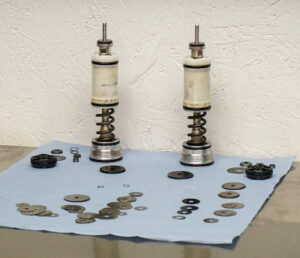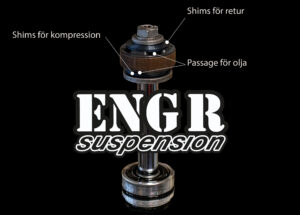As Supermoto pilots, we learn that it is important to have the right suspension. Usually because you start driving on an SXF/KX/YZ type model, or similar, that is adapted for motocross or enduro riding. When you ride a bike with suspension built for the forest or motocross track on asphalt, the experience often becomes that the bike feels soft. You can turn the [screws] on the suspension to adjust, but what makes the biggest difference is still to configure your shims setup.
What does the shims stack actually do?
Whether you’re looking at your front fork or the rear shock absorber, the principle for
configuring your shims stack is the same. There’s a spring that carries the weight of the bike (see also A bike of a spring) and oil that moves past a piston and valves in both your front and rearend suspension. The piston and valves regulate how fast the shock absorber moves depending on what we expose the suspension to. K-tech has a nice animation on the whole process here..
When you land after a jump, for example, you might want the suspension to be pressed together relatively quickly at the beginning of the landing and then slowly at the end, to give that cozy sense of safety.
When the suspension moves, the oil is pushed through cavities in the piston and through different valves. The valves can be easily adjusted by the rider at any given time, by adjusting what is called return and compression.
The return regulates how much oil should be allowed to flow through the valve when the suspension is actively working – after a completed braking scenario, or after a landing for example.
The compression does the opposite. It regulates the flow of oil when we compress the suspension. A good start, if you have enduro or motocross suspension, [is to turn the compression so that the bike does not come into braking.]
The top and bottom of the plunger are partially covered by a number of washers called shims. The plunger allows a certain amount of oil to pass through without the shim reacting. When the pressure from the oil is high enough, the shim bends. The higher the pressure that comes from the oil, the more the shim bends, which in turn allows more oil to pass. In our example where you land after a jump, the impact occurs a high pressure from the oil when a large amount of oil wants to pass very fast. The suspension allows through the amount of oil for which it is configured, and the pressure decreases as the suspension slows down the movement. When the pressure from the oil decreases, the shims returns to its closed position.
For example, a suspension that is not suitable for you and your driving can bottom directly into the impact or be so sluggish that you can feel the impact all over your body. You can of course adjust the experience, to some extent, via return and compression, something that we will talk more about later.
But how do you know if you need to adjust your shims configuration?
The simplest answers to any technical question is of course to ask an expert, so we’ve just done that – we spoke to Mattias at Eng Racing.
-You should configure your shims setup in your suspension when you have used up all the adjustment on their dampers, or if you want to change the way the bike behaves. The scenario could vary from the rider wanting to use their enduro bike for motocross, or a supermoto that has an undesired behavior in on the tarmac. We’ve for example configured the shims setup and suspension on brand new factory configured FS450 based on settings from the Andreani database, and the drivers have been pleasantly surprised by how much difference it has made to their driving.
How hard is it really to change the shims configuration on a suspension?
– Work-wise, it’s not that hard. It obviously takes time to unscrew the suspension. But if you want a good setting altogether, it of course takes a lot of work. You need to try, test, adjust, try again and preferably drive a many different bikes and configurations to understand what you prefer. Changing a few shims can make a very big difference in how the bike behaves. It’s really important to have an open dialogue with your suspension or service technician so that they understand what you are experiencing on the bike so that they can learn what you prefer. No one will be happy to rebuild a suspension that you are not happy with, it really is a collaboration to make your bike as great as you are and to match your skills.
This post is also available in: Svenska









